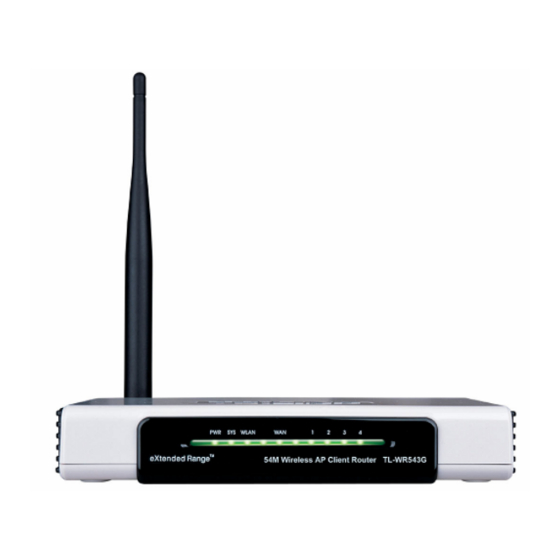
Table of Contents
Advertisement
Quick Links
Please use only wired network connections to configure the router.
Note
Connect the WAN port on
your Router to the Modem's
LAN port with an Ethernet
cable.
If connecting the TL-WR543G to the WISP (Wireless Internet Service
Note
Provider), please skip to the next step.
Connect your computer to the
TL-WR543G with an Ethernet
cable.
Plug the provided Power
Adapter into the Power
jack on the back of the
Router and the other end
to a standard electrical wall
socket.
1
Advertisement
Table of Contents

Summary of Contents for TP-Link TL-WR543G
- Page 1 Connect the WAN port on your Router to the Modem’s LAN port with an Ethernet cable. If connecting the TL-WR543G to the WISP (Wireless Internet Service Note Provider), please skip to the next step. Connect your computer to the TL-WR543G with an Ethernet cable.
- Page 2 Turn on all of your network devices, including your computer, Modem and the Router then check to see if the LEDs of the Router display normally as the digram below describes. PWR: Solid light SYS/WLAN: Flashing WAN: Flashing or solid light if the WAN port is connected LAN: Flashing or solid light if the corresponding port is connected...
- Page 3 A dialog box will prompt you for the User name and Password. Enter the default values and click OK. User name: admin Password: admin Click OK If the dialog box does not pop up, please refer to T3 in the Troubleshooting Note guide on page 8.
- Page 4 Internet Parameters Configuration This page will then display. Click Next Choose the operation mode for the TL-WR543G. AP Client Router mode is for connecting to the WISP (Wireless Internet Service Provider); AP Router is for connecting to the common ISP using cable connection.
- Page 5 Configuration for PPPoE If you select PPPoE, this page will then display. Enter the Account Name and Password provided by your ISP. Click Next Configuration for Dynamic IP If you select Dynamic IP, you will be prompted to configure the wireless settings as seen in section 3 Wireless Settings Confituration.
- Page 6 Wireless Settings Configuration This page will then display Keep the default setting Enable. If you want to disable wireless, please select Disable. Create a unique and easy to remember name your wireless network. You can also keep the default setting without the device being affected.
- Page 7 The basic settings for your Router are completed. Please open the web browser and log on to the following websites: http://www.tp-link.com http://www.google.com If the above websites can be accessed, it indicates that your Router has been configured successfully and you can begin to enjoy the Internet. If the website cannot be accessed, please refer to “T4.
- Page 8 T1. How do I restore my Router’s configuration to its factory default settings? With the Router powered on, press and hold the Reset button on the rear panel for 8 to 10 seconds before releasing it. Press it for 8 to 10 seconds Once the Router is reset, the current configuration settings will be lost and Note you will need to re-configure the Router.
- Page 9 Click Network Connections Right-click Local Area Connection Click Properties Double-click Internet Protocol (TCP/IP)
- Page 10 Select Obtain an IP address automatically Select Obtain DNS server address automatically Click OK Click OK...
- Page 11 For Windows Vista OS Go to Start > Settings > Control Panel, and then you will see the following page. Click View network status and tasks Click View status Click Properties...
- Page 12 Double-click Internet Protocol Version 4 (TCP/IPv4). Select Obtain an IP address automatically Select Obtain DNS server address automatically Click OK...
- Page 13 2) Configure your IE browser Open your IE browser, click Tools tab and you will see the following screen. Click Internet Options… Select Never dial a connection Click OK Now, try to log on to the Web-based configuration page again after the above settings have been configured.
- Page 14 Check to see if you can access the Router’s web management page. If you can, please follow the following steps to solve the problem. If you can’t, please set your computer referring to section T3 then try to access the Internet again. If the problem persists, please go to the next step.
- Page 15 Log on to the WEB Management page. Click Wireless Settings on the leftmost side. Click Wireless Settings Check Enable Wireless Security box. Select WPA-PSK/WPA2-PSK Enter a security key using more than 8 characters (using numbers or letters). Click Save...
-
Page 16: Technical Support
Technical Support For more troubleshooting help, go to: www.tp-link.com/support/faq.asp To download the latest Firmware, Driver, Utility and User Guide, go to: www.tp-link.com/support/download.asp For all other technical support, please contact us by using the following details: Global Australia & New Zealand Tel: +86 755 26504400 Tel: AU 1300 87 5465...














